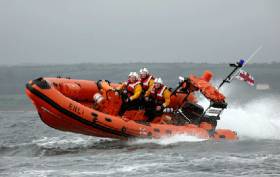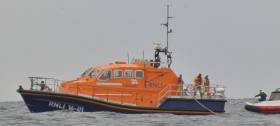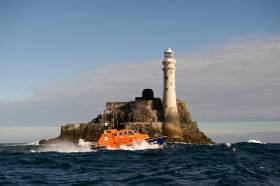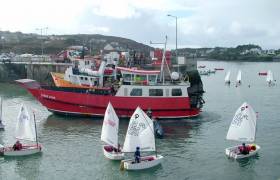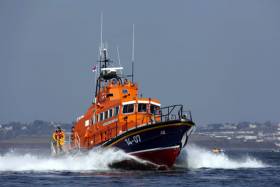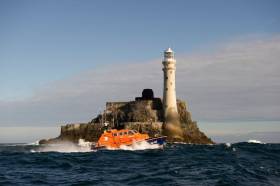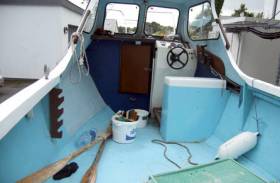Displaying items by tag: west cork
Teen Anglers Rescued In Glandore Harbour By Union Hall Lifeboat
#RNLI - Union Hall RNLI were tasked yesterday evening (Friday 11 August) by Valentia Coast Guard to a 16ft pleasure craft with five teenagers aboard that suffered engine failure in West Cork’s Glandore Harbour.
The lifeboat was launched and underway at 6.05pm to go to the aid of the casualty vessel, whose passengers had been angling at the eastern entrance of the harbour.
In favourable weather conditions, the Union Hall lifeboat was on scene within a few minutes to assist the pleasure craft as its position was a mere 15 feet away from rocks.
Following the incident, the five teenagers and their parents called to the lifeboat station to thank the volunteer crew for coming to their aid.
Martin Limrick, Union Hall RNLI volunteer lifeboat crew member, said: “The teenagers did everything right. They rang for help, deployed their anchor and were all wearing lifejackets.
“We would urge people when heading out on the water to have a means of communication, always wear a lifejacket and to respect the water.”
Fastnet Callout Sees Baltimore Lifeboat Bring Two To Safety
#RNLI - Two people watching the Fastnet Race fleet round the famous rock from a RIB yesterday (Tuesday 8 August) were rescued by Baltimore RNLI when their boat lost power.
The volunteer lifeboat crew, who were already on exercise in the area of Fastnet Rock, were alerted by a call from a nearby vessel at 3.15pm that another boat with two people onboard had lost the use of their engine.
The all-lifeboat was only two miles from the casualty vessel, a 7.5m RIB. Conditions at the time were good with a north-westerly Force 2-3 wind and a one-metre sea swell.
Once on scene, the lifeboat crew established a tow and brought the vessel back to Baltimore Harbour in West Cork, securing her to the pontoon before returning to the lifeboat station at 4.20pm.
Kate Callanan, Baltimore RNLI volunteer lifeboat press officer, commented: “Thankfully the lifeboat crew were on scene very quickly after the call was raised.
“Baltimore RNLI has a strong connection to the Fastnet Race having been involved in a number of dramatic rescues over the years. The lifeboat crew regularly exercise during the famous race to be nearby in case they receive a call for help.”
Elsewhere, Wicklow’s all-weather lifeboat launched at on Monday night (7 August) to assist two sailors on a yacht in difficulties about two miles north-east of Wicklow Harbour.
The eight-metre yacht was on passage south when it developed engine problems. The skipper contacted the Irish Coast Guard for assistance as they were unable to make any progress due to the lack of wind.
Under the command of second coxswain Ciaran Doyle, the lifeboat was alongside the casualty six minutes after launching. Conditions in the area had a calm sea state with light airs and good visibility.
A towline was quickly established and the yacht was brought back to Wicklow Harbour, where it was safely secured alongside the East Pier before midnight.
Arctic ‘Bearded’ Seal In West Cork Baffles Experts
#MarineWildlife - Wildlife watchers have been baffled by the sighting of an Arctic seal in West Cork, as the Irish Examiner reports.
Bearded seals, marked by their pale pelt and distinctive long whiskers, are usually found between the far north of Canada, Greenland and the Russian Arctic.
But as photographed in recent days by Shearwater Wildlife Tours, one appears to have taken up residence in the much milder climes of Timoleague, near Courtmacsherry in West Cork.
And it’s been suggested in comments that the heavyweight seal has been living in the area for at least the last two months.
It marks only the second recorded sighting of this marine mammal species in Ireland, the other being a female in distress who was nursed back to health in Galway in 2002, according to Shearwater’s Paul Connaughton, who is also chair of Birdwatch Ireland’s West Cork branch.
Others have been found in the Scotland’s Shetland and Orkney Islands, but fewer than 20 are on record.
Now experts are speculating as to whether melting sea ice in their Arctic home is prompting these seals to seek refuge further south.
The Irish Examiner has much more on the story HERE.
Baltimore Lifeboat Secures Vessels In Trouble At Crookhaven
#RNLI - In the first of two incidents yesterday morning (Thursday 3 August), Baltimore RNLI launched to reports of a vessel adrift in Crookhaven Harbour.
The vessel, a 4m Boston Whaler powerboat, had broken from its mooring in strong winds and was drifting outside the West Cork harbour.
There was no one on board the vessel, and weather conditions at the time were poor, with an easterly force 6-7 wind and 4-5m sea swell.
Baltimore's lifeboat arrived on scene at 8.38am, some 51 minutes after launch, and established a tow to bring the vessel back into the harbour, where it was secured to a mooring.
As the lifeboat was departing to return to station at 9.11am, the Irish Coast Guard contacted them to investigate another boat in trouble in the area.
The second vessel, a 20ft Merry Fisher pleasure boat with no people on board, had gone ashore on rocks in Crookhaven.
Due to the position of the vessel on the shoreline, coxswain Aidan Bushe decided to launch the Y-boat from the stern ramp of the lifeboat.
The Y-boat, with Kieran Collins and David Ryan on board, secured a tow and pulled the casualty vessel clear of the shoreline. The lifeboat then took up the tow and secured the vessel on a mooring.
Speaking following the callout, Baltimore RNLI volunteer lifeboat press officer Kate Callanan said: “It is advisable in such incidents, where boats get into trouble near the shoreline, to call the coastguard for assistance. This reduces the risk of people getting themselves into a dangerous situation.
“If you get into difficulty at sea, call 999 or 112 and ask for the coastguard.”
Bushe, Ryan and Collins were joined on yesterday’s callout by mechanic Sean McCarthy and crew members Jerry Smith and Don O’Donovan. Micheal Cottrell provided shore crew assistance at the lifeboat house.
Lost Boats Led To Forming Baltimore Sailing Club
Baltimore will become a centre for sailing over the next few weeks. This August weekend the annual sailing trek to the waters around Carbery’s Hundred Isles will get underway with the annual overnight race from Crosshaven to Schull. For the next few weeks the Cork sailing fraternity will be joined by boats from the East Coast, taking in events like Calves Week, Baltimore Regatta, racing around the Fastnet and the legendary Cape Clear Regatta.
The date when the club was founded varies, according to which account you take it from. A list of Commodores in the club starts in 1952 but a letter dated 3rd August 1976, written by Frank Murphy, who was the first Secretary of the club, stated that the club was founded in the summer of 1953. However, the Minutes of a Meeting held at Salters premises in Baltimore on Saturday 28th July 1956 state that "It was unanimously felt that a Sailing Club should be formed”
On my podcast this week I talk to a former Commodore of the Club, Gerald O’Flynn, who puts that date as the one when the club was formed.
Its story, set up originally as a Summer sailing club for Cork families with second homes in the fishing village, began when some of those seasonal residents lost boats in storms while they were kept at nearby Tragumna beach.
Gerald O’Flynn tells the story of boats built and bought for £75 each in ‘old’ money; about a ‘bastard-type’ of National 18, Enterprises and Fireball dinghies used by the club, the running of National Dinghy Week and the time when the club annoyed locals by covering grass areas on the pier with concrete. It’s a fascinating story about a club with a strong family emphasis which he told me in its modern premises which these days operates for a wider period than just Summer.
Listen to the PODCAST here:
• Tom MacSweeney presents THIS ISLAND NATION radio programme on local stations around Ireland.
Engine Failure On West Cork Fishing Trip Vessel Prompts Courtmacsherry Lifeboat Rescue
#RNLI - Courtmacsherry RNLI’s all-weather lifeboat was called out at 4.20pm yesterday afternoon (Tuesday 1 August) to go to the aid of a 40ft pleasure fishing boat with mechanical failure 15 miles off the Seven Heads in West Cork.
The Courtmacsherry Lifeboat, under coxswain Kevin Young and with a crew of six, launched in minutes and reached the stricken boat just after 5pm.
On scene near the Lusitania site, the lifeboat secured a tow line to the vessel and then proceeded to tow it back to the safe haven of Courtmacsherry’s inner harbour.
All six on the pleasure boat were safely returned to Courtmacsherry Pontoon at 8pm.
Weather conditions on the callout reasonable, with winds in the area blowing Force 3-4.
The callout was the latest in what was a busy 48 hours for the voluntary crew of Courtmacsherry RNLI, with three callouts to boats in distress beginning on Sunday afternoon with the rescue of another pleasure fishing boat, as previously reported on Afloat.ie.
#RNLI - Baltimore RNLI launched this morning (Friday 28 July) to locate a vessel sending an alarm from their positioning beacon off the coast of West Cork.
The Irish Coast Guard requested the launch just before 10am after it had picked up an alarm from an EPIRB (electronic position indication radio beacon) on a yacht half a mile south west of Cape Clear Island.
Coastguard staff at Mizen Head had no success raising the occupants of the yacht on their VHF so the Baltimore all-weather lifeboat was launched to investigate at the last known co-ordinates of the vessel.
Meanwhile, 10.30am the coastguard finally made contact with the yacht’s two occupants on their VHF and established that the EPIRB had been activated by accident.
Speaking after the callout, Baltimore RNLI volunteer lifeboat navigator Micheal Cottrell said: “It is important to ensure the secure fastening of an EPIRB on board a vessel and to regularly check that it is in good working order. Also, whilst out at sea it is important to keep radio watch on Channel 16.
“If you get into difficulty at sea, call 999 or 112 and ask for the coastguard.”
#RNLI - Union Hall RNLI were alerted by Valentia Coast Guard at 3.24pm yesterday (Saturday 22) to a report of a 30ft yacht with two sailors gone aground at the middle danger in Glandore Harbour, West Cork.
The lifeboat launched and was underway to the yacht at 3.33pm in favourable weather conditions, with a slight breeze from the north.
While en route to the scene, a member of the public notified the lifeboat station that the yacht had refloated safely. The volunteer crew subsequently spoke to the sailors, who were happy to continue sailing.
Union Hall RNLI deputy launch authority Peter Deasy said: “While a lot of activity is taking place in Glandore Harbour this week with the Glandore Classic Boat Regatta, we advise people to be alert, obey navigation aids and respect the water. If you see someone in trouble dial 999/112 and ask for the coastguard.”
#WaterSafety - The dangers of boating without proper safety equipment have been raised by a report into the death of an angler who went overboard from his vessel off West Cork last summer.
The body of Michael O’Brien was recovered on the morning of 15 August 2016, after he was reported missing the previous evening when he failed to return to Schull from a solo fishing trip.
The Marine Casualty Investigation Board (MCIB) report into the incident found that O’Brien, who regularly went angling around Long Island Bay in the summer months, was not wearing a PFD and had no emergency beacon or VHF radio, with only a mobile phone for communication.
It’s unknown how the 69-year-old came to enter the water, but his reduced mobility due to a hip operation and the fact that his crutches were found stowed suggests he used the boat’s bulwarks for support, which would have put his centre of gravity over the edge of the vessel.
The full MCIB report can be downloaded below.
€200,000 Cape Clear Pontoons On the Way for West Cork Island
The good news for West Cork boaters is that the €200,000 pontoons procured for Cape Clear island's North Harbour will be installed this Summer. And as our photo taken this week shows there's little doubt that they will be put to immediate use.
Under the 2017 fishery harbour and coastal infrastructure capital programme, Junior Minister Andrew Doyle told the Dail Harbour's debate in June he had allocated €720,000 for maintenance and development works at the Island's North Harbour. 'The 2017 programme provides €200,000 for pontoons at Cape Clear and €250,000 for the design, preparation of contract documents and planning for additional repair work to Duffy's Pier' he said.
After storm damage wrecked the coastal infrastructure there, construction work has been underway at Cape Clear island since 2014. As Afloat previously reported in March that year, the works have involved the construction of a slipway; replacement of the Bull's Nose structure incorporating a storm gate and an extension to the end of Duffy's Pier; excavation, dredging and reclamation works including the construction of an armoured embankment at the seaward side of the new Bull's Nose structure.
It is expected the Duffy’s Pier preparatory work will also be completed in 2017. However, further work will be subject to permission and funding in future years.





























